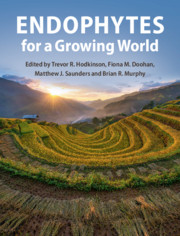Book contents
- Endophytes for a Growing World
- Endophytes for a Growing World
- Copyright page
- Contents
- Contributors
- Preface
- Part I Introduction
- Part II Role of Endophytes in Growth and Biotic and Abiotic Stress Resistance
- Part III Diversity and Community Ecology of Endophytes
- Part IV Endophytes for Novel Biomolecules and In Vitro Methods
- 13 Endophytic Fungi: A Quintessential Source of Potential Bioactive Compounds
- 14 Enhancing Secondary Metabolite Production in Medicinal Plants Using Endophytic Elicitors: A Case Study of Centella asiatica (Apiaceae) and Asiaticoside
- 15 In Vitro Methods for Plant–Microbe Interaction and Biocontrol Studies in European Ash (Fraxinus excelsior L.)
- Part V Application and Commercialisation of Endophytes in Crop Production
- Index
- References
14 - Enhancing Secondary Metabolite Production in Medicinal Plants Using Endophytic Elicitors: A Case Study of Centella asiatica (Apiaceae) and Asiaticoside
from Part IV - Endophytes for Novel Biomolecules and In Vitro Methods
Published online by Cambridge University Press: 01 April 2019
- Endophytes for a Growing World
- Endophytes for a Growing World
- Copyright page
- Contents
- Contributors
- Preface
- Part I Introduction
- Part II Role of Endophytes in Growth and Biotic and Abiotic Stress Resistance
- Part III Diversity and Community Ecology of Endophytes
- Part IV Endophytes for Novel Biomolecules and In Vitro Methods
- 13 Endophytic Fungi: A Quintessential Source of Potential Bioactive Compounds
- 14 Enhancing Secondary Metabolite Production in Medicinal Plants Using Endophytic Elicitors: A Case Study of Centella asiatica (Apiaceae) and Asiaticoside
- 15 In Vitro Methods for Plant–Microbe Interaction and Biocontrol Studies in European Ash (Fraxinus excelsior L.)
- Part V Application and Commercialisation of Endophytes in Crop Production
- Index
- References
Summary
Fungal endophytes are a vital component of the plant microbiome. The symbiotic relationship between endophytic fungi and medicinal plants can considerably influence plant secondary metabolism pathways, thus affecting their metabolite production and the quality and quantity of crude drugs produced. This chapter focuses on how fungal endophytic symbiosis can increase production of secondary metabolites during in vitro culture. Other than promoting secondary metabolite accumulation, endophytic fungi can also promote the growth of host plants and improve their resistance to abiotic and biotic stresses. Therefore, an understanding of the relationship between endophytic fungi and their host medicinal plants is of utmost importance. This knowledge can be applied in the production of novel and improved drugs from medicinally valued plants. In vitro elicitation of secondary metabolites by endophytic fungi has been reported in several medicinal plants. A case study is documented in this chapter which shows enhancement of asiaticoside by an endophytic fungal (Colletotrichum gloeosporioides) elicitor isolated from in vivo grown plants of Centella asiatica. These findings may motivate further exploitation of fungal endophytes as an effective and beneficial way to enhance the production of pharmacologically important compounds from medicinal plants.
- Type
- Chapter
- Information
- Endophytes for a Growing World , pp. 310 - 327Publisher: Cambridge University PressPrint publication year: 2019
References
- 20
- Cited by

